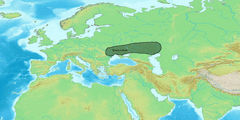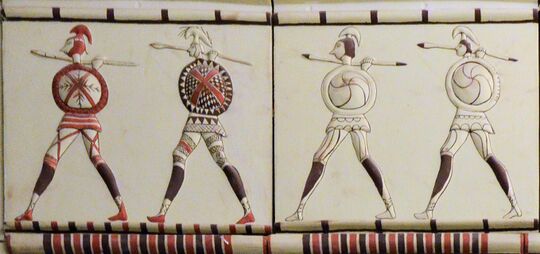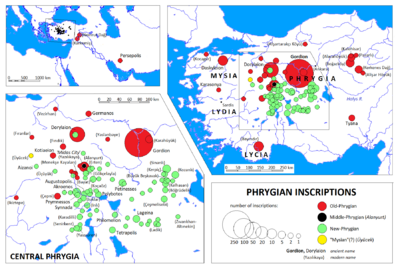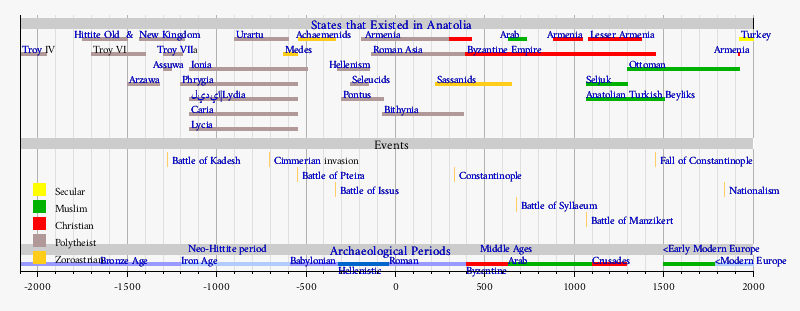فريغ (شعب)
| جزء من سلسلة عن |
| المواضيع الهندو-أوروپية |
|---|
 |
الفريگ أو الفريغ ( Phrygians ؛ باليونانية: Φρύγες ، فروگـِس أو فريگـِس) كانوا شعب قديم ناطق بلغة هندو-أوروپية، سكن وسط-غرب الأناضول في القِدم. وكانوا على صلة باليونانيين.[1]
استخدم المؤلفون اليونانيون القدماء كلمة "فريگ" كمصطلح شامل لوصف عقدة عرقية-ثقافية واسعة تقع أساساً في المناطق الوسطى للأناضول بدلاً من استخدام اسم "قبيلة" أو "شعب" معين، خاصةً أن تجانسه العرقي-اللغوي هو موضع جدل.[2] كان الفريگ يقطنون، في الأصل، جنوب البلقان – حسب هيرودوت – تحت اسم بريگ Bryges (Briges)، ثم تغير الاسم إلى فريگ بعد هجرتهم النهائية إلى الأناضول، عبر الدردنيل. إلا أن الأصول البلقانية للفريگ يشكك فيها الدارسون المعاصرون.[3][4]
طوّرت فريگيا ثقافة متقدمة في العصر البرونزي. The earliest traditions of Greek music are in part connected to Phrygian music, transmitted through the Greek colonies in Anatolia, especially the Phrygian mode, which was considered to be the warlike mode in ancient Greek music. Phrygian Midas, the king of the "golden touch", was tutored in music by Orpheus himself, according to the myth. Another musical invention that came from Phrygia was the aulos, a reed instrument with two pipes. In classical Greek iconography Paris, a Trojan, is represented as non-Greek by his Phrygian cap, which was also worn by Mithras and survived into modern imagery as the "Liberty cap" of the American and French revolutionaries.
Phrygians spoke the Phrygian language, a member of the Indo-European linguistic family. Modern consensus regards Greek as its closest relative.[5][6][7][8]
التاريخ
A conventional date of c. 1180 BC is often used for the influx (traditionally from Thrace) of the pre-Phrygian Bryges or Mushki, corresponding to the very end of the Hittite empire. Following this date, Phrygia retained a separate cultural identity. From tribal and village beginnings, the state of Phrygia arose in the 8th century BC with its capital at Gordium. Around 690 BC, it was invaded by the Cimmerians. Phrygia was briefly conquered by its neighbour Lydia, before it passed successively into the Persian Empire of Cyrus the Great and later the empire of Alexander and his successors. Later, it was taken by the Attalids of Pergamon, and eventually became part of the Roman Empire. The last mention of the Phrygian language in literature dates to the 5th century AD and it was likely extinct by the 7th century.[9]
الهجرة
After the collapse of the Hittite Empire at the beginning of the twelfth century BC, the political vacuum in central-western Anatolia was filled by a wave of Indo-European migrants and "Sea Peoples", including the Phrygians, who established their kingdom with a capital eventually at Gordium. It is presently unknown whether the Phrygians were actively involved in the collapse of the Hittite capital Hattusa or whether they simply moved into the vacuum left by the collapse of Hittite hegemony. The so-called Handmade Knobbed Ware was found by archaeologists at sites from this period in Western Anatolia. According to Greek mythographers,[10] Midas had been king of the Phrygians, who were originally called the Bryges (Brigi) and came from the western part of archaic Thrace or Macedon. Midas has been linked to the Mushki king Mita. However, the origins of the Mushki, and their connection to the Phrygians, is uncertain.[11][12][13] Some scholars have suggested that Mita was a Luwian name (it was recorded in Asia Minor in the 15th century BCE).[14]
Though the migration theory is still defended by many modern historians, most archaeologists have abandoned the migration hypothesis regarding the origin of the Phrygians due to a lack substantial archeological evidence, with the migration theory resting only on the accounts of Herodotus and Xanthus.[15][16]
القرنان الثامن إلى السابع
Assyrian sources from the 8th century BC speak of a king Mita of the Mushki, identified with king Midas of Phrygia. An Assyrian inscription records Mita as an ally of Sargon of Assyria in 709 BC. A distinctive Phrygian pottery called Polished Ware appears in the 8th century BC. The Phrygians founded a powerful kingdom which lasted until the Lydian ascendancy (7th century BC). Under kings alternately named Gordias and Midas, the independent Phrygian kingdom of the 8th and 7th centuries BC maintained close trade contacts with her neighbours in the east and the Greeks in the west. Phrygia seems to have been able to co-exist with whatever power was dominant in eastern Anatolia at the time.
The invasion of Anatolia in the late 8th century BC to early 7th century BC by the Cimmerians was to prove fatal to independent Phrygia. Cimmerian pressure and attacks culminated in the suicide of its last king, Midas, according to legend. Gordium fell to the Cimmerians in 696 BC and was sacked and burnt, as reported much later by Herodotus.
A series of digs have opened Gordium as one of Turkey's most revealing archeological sites. Excavations confirm a violent destruction of Gordion around 675 BC. A tomb of the Midas period, popularly identified as the "Tomb of Midas" revealed a wooden structure deeply buried under a vast tumulus, containing grave goods, a coffin, furniture, and food offerings (Archaeological Museum, Ankara). The Gordium site contains a considerable later building program, perhaps by Alyattes, the Lydian king, in the 6th century BC.
Minor Phrygian kingdoms continued to exist after the end of the Phrygian empire, and the Phrygian art and culture continued to flourish. Cimmerian people stayed in Anatolia but do not appear to have created a kingdom of their own. The Lydians repulsed the Cimmerians in the 620s, and Phrygia was subsumed into a short-lived Lydian empire. The eastern part of the former Phrygian empire fell into the hands of the Medes in 585 BC.
امبراطورية كروسوس الليدية
Under the proverbially rich King Croesus (reigned 560–546 BC), Phrygia remained part of the Lydian empire that extended east to the Halys River. There may be an echo of strife with Lydia and perhaps a veiled reference to royal hostages, in the legend of the twice-unlucky Adrastus, the son of a King Gordias with the queen, Eurynome. He accidentally killed his brother and exiled himself to Lydia, where King Croesus welcomed him. Once again, Adrastus accidentally killed Croesus' son and then committed suicide.
تاريخ ما بعد الدولة
Lydian Croesus was conquered by Cyrus in 546 BC, and Phrygia passed under Persian dominion. After Darius became Persian Emperor in 521 BC, he remade the ancient trade route into the Persian "Royal Road" and instituted administrative reforms that included setting up satrapies (provinces). In the 5th century, Phrygia was made into two administrative provinces, that of Hellespontine Phrygia (or Lesser Phrygia), with its provincial capital established at Dascylium, and the province of Greater Phrygia.
الثقافة
اللغة
The Phrygian language is a member of the Indo-European linguistic family with its exact position within it having been debated due to the fragmentary nature of its evidence. Though from what is available it is evident that Phrygian shares important features with Greek and Armenian. Phrygian is part of the centum group of Indo-European languages. However, between the 19th and the first half of the 20th century Phrygian was mostly considered a satəm language, and thus closer to Armenian and Thracian, while today it is commonly considered to be a centum language and thus closer to Greek.[17] The reason that in the past Phrygian had the guise of a satəm language was due to two secondary processes that affected it. Namely, Phrygian merged the old labiovelar with the plain velar, and secondly, when in contact with palatal vowels /e/ and /i/, especially in initial position, some consonants became palatalized. Furthermore, Kortlandt (1988) presented common sound changes of Thracian and Armenian and their separation from Phrygian and the rest of the palaeo-Balkan languages from an early stage.[7][18]
Modern consensus regards Greek as the closest relative of Phrygian, a position that is supported by Brixhe, Neumann, Matzinger, Woodhouse, Ligorio, Lubotsky, and Obrador-Cursach. Furthermore, 34 out of the 36 Phrygian isoglosses that are recorded are shared with Greek, with 22 being exclusive between them. The last 50 years of Phrygian scholarship developed a hypothesis that proposes a proto-Graeco-Phrygian stage out of which Greek and Phrygian originated, and if Phrygian was more sufficiently attested, that stage could perhaps be reconstructed.[7][8][19][20][21]
الآثار
Based on an extremely slight archaeological record, some scholars such as Nicholas Hammond and Eugene N. Borza suggested that the Phrygians were members of the Lusatian culture that migrated into the southern Balkans during the Late Bronze Age.[22][23] However, the lack of western (European) ceramic ware, and the continuation of the pre-Bronze Age collapse pottery styles in central Asia Minor, have led some scholars to reject a Balkan or European origin for the Phrygians.[24][25]
الدين
It was the "Great Mother", Cybele, as the Greeks and Romans knew her, who was originally worshipped in the mountains of Phrygia, where she was known as "Mountain Mother". In her typical Phrygian form, she wears a long belted dress, a polos (a high cylindrical headdress), and a veil covering the whole body. The later version of Cybele was established by a pupil of Phidias, the sculptor Agoracritus, and became the image most widely adopted by Cybele's expanding following, both in the Aegean world and at Rome. It shows her humanized though still enthroned, her hand resting on an attendant lion and the other holding the tympanon, a circular frame drum, similar to a tambourine.
The Phrygians also venerated Sabazios, the sky and father-god depicted on horseback. Although the Greeks associated Sabazios with Zeus, representations of him, even at Roman times, show him as a horseman god. His conflicts with the indigenous Mother Goddess, whose creature was the Lunar Bull, may be surmised in the way that Sabazios' horse places a hoof on the head of a bull, in a Roman relief at the Museum of Fine Arts, Boston.
روايات أسطورية
The name of the earliest known mythical king was Nannacus (aka Annacus).[26] This king resided at Iconium, the most eastern city of the kingdom of Phrygia at that time, and after his death, at the age of 300 years, a great flood overwhelmed the country, as had been foretold by an ancient oracle. The next king mentioned in extant classical sources was called Manis or Masdes. According to Plutarch, because of his splendid exploits, great things were called "manic" in Phrygia.[27] Thereafter the kingdom of Phrygia seems to have become fragmented among various kings. One of the kings was Tantalus who ruled over the north western region of Phrygia around Mount Sipylus. Tantalus was endlessly punished in Tartarus, because he allegedly killed his son Pelops and sacrificially offered him to the Olympians, a reference to the suppression of human sacrifice. Tantalus was also falsely accused of stealing from the lotteries he had invented. In the mythic age before the Trojan war, during a time of an interregnum, Gordius (or Gordias), a Phrygian farmer, became king, fulfilling an oracular prophecy. The kingless Phrygians had turned for guidance to the oracle of Sabazios ("Zeus" to the Greeks) at Telmissus, in the part of Phrygia that later became part of Galatia. They had been instructed by the oracle to acclaim as their king the first man who rode up to the god's temple in a cart. That man was Gordias (Gordios, Gordius), a farmer, who dedicated the ox-cart in question, tied to its shaft with the "Gordian Knot". Gordias refounded a capital at Gordium in west central Anatolia, situated on the old trackway through the heart of Anatolia that became Darius's Persian "Royal Road" from Pessinus to Ancyra, and not far from the River Sangarius.
Later mythic kings of Phrygia were alternately named Gordias and Midas. Myths surround the first king Midas. There were seven altogether connecting him with a mythological tale concerning Attis.[28] This shadowy figure resided at Pessinus and attempted to marry his daughter to the young Attis in spite of the opposition of his mother figure Agdestis and his lover, the goddess Cybele. When Agdestis or Cybele appear and cast madness upon the members of the wedding feast. Midas is said to have died in the ensuing chaos.
The famous king Midas was said to be a son of the kind Gordius mentioned above. He is said to have associated himself with Silenus and other satyrs and with Dionysus, who granted him the famous "golden touch".
The mythic Midas of Thrace, accompanied by a band of his people, traveled to Asia Minor to wash away the taint of his unwelcome "golden touch" in the river Pactolus. Leaving the gold in the river's sands, Midas found himself in Phrygia, where he was adopted by the childless king Gordias and taken under the protection of Cybele. Acting as the visible representative of Cybele, and under her authority, it would seem, a Phrygian king could designate his successor.
According to the Iliad, the Phrygians were Trojan allies during the Trojan War. The Phrygia of Homer's Iliad appears to be located in the area that embraced the Ascanian lake and the northern flow of the Sangarius river and so was much more limited in extent than classical Phrygia. Homer's Iliad also includes a reminiscence by the Trojan king Priam, who had in his youth come to aid the Phrygians against the Amazons (Iliad 3.189). During this episode (a generation before the Trojan War), the Phrygians were said to be led by Otreus and Mygdon. Both appear to be little more than eponyms: there was a place named Otrea on the Ascanian Lake, in the vicinity of the later Nicaea; and the Mygdones were a people of Asia Minor, who resided near Lake Dascylitis (there was also a Mygdonia in Macedonia). During the Trojan War, the Phrygians sent forces to aid Troy, led by Ascanius and Phorcys, the sons of Aretaon. Asius, son of Dymas and brother of Hecabe, is another Phrygian noble who fought before Troy. Quintus Smyrnaeus mentions another Phrygian prince, named Coroebus, son of Mygdon, who fought and died at Troy; he had sued for the hand of the Trojan princess Cassandra in marriage. King Priam's wife Hecabe is usually said to be of Phrygian birth, as a daughter of King Dymas.
The Phrygian Sibyl was the priestess presiding over the Apollonian oracle at Phrygia.
Marsyas, a Phrygian follower of Cybele, was a satyr who is regarded as the inventor of the aulos, which he created using the hollowed antler of a stag. He unwisely competed in music with the Olympian Apollo and inevitably lost, whereupon Apollo flayed Marsyas alive and provocatively hung his skin on Cybele's own sacred tree, a pine.
Herodotus,[29] claims the priests of Hephaestus told him a story that the Egyptian pharaoh Psammetichus had two children raised in isolation in order to find the original language. The children were reported to have uttered bekos meaning "bread" in Phrygian. It was then acknowledged by the Egyptians that the Phrygians were a nation older than the Egyptians.
Josephus claimed the Phrygians were founded by the biblical figure Togarmah, grandson of Japheth and son of Gomer: "and Thrugramma the Thrugrammeans, who, as the Greeks resolved, were named Phrygians".
انظر أيضاً
المراجع
- ^ Henry, Roger (2003). Synchronized Chronology: Rethinking Middle East Antiquity (in الإنجليزية). Algora Publishing. p. 116. ISBN 978-0-87586-185-2.
The Phrygians (a people closely related to the Greeks) moved into central Asia Minor in the ninth century BC.
- ^ Oreshko, Rostislav (2020). "The onager kings of Anatolia: Hartapus, Gordis, Muška and the steppe strand in early Phrygian culture". Kadmos. De Gruyter. 59 (1/2): 77–128. doi:10.1515/kadmos-2020-0005. S2CID 235451836. pp. 82–83.
- ^ Drews, Robert (1995). The end of the Bronze Age: changes in warfare and the catastrophe ca. 1200 B.C. Princeton University Press. p. 65. ISBN 9780691025919.
- ^ Kopanias, Konstantinos (2015), "The Mushki/Phrygian Problem from the Near Eastern Point of View", In: Nostoi. Indigenous Culture, Migration and Integration in the Aegean Islands and Western Anatolia During the Late Bronze and Early Iron Age. Proceedings of the International Conference Istanbul 2011, Edited by Ν. Stampolides, C. Maner, and K. Kopanias. Istanbul: Koç University Press, https://www.academia.edu/4580510
- ^ Brixhe, Cl. "Le Phrygien". In Fr. Bader (ed.), Langues indo-européennes, pp. 165-178, Paris: CNRS Editions.
- ^ Hajnal, Ivo. ""Urgriechisch": Eine Herausforderung für die Methode der Rekonstruktion?" (PDF). Institut für Sprachwissenschaft (in الألمانية). Innsbruck, Austria: Universität Innsbruck. p. 8. Retrieved 4 March 2021.
- ^ أ ب ت Woodhouse, Robert (2009). "An overview of research on Phrygian from the nineteenth century to the present day". Studia Linguistica Universitatis Iagellonicae Cracoviensis. 126 (1): 171. doi:10.2478/v10148-010-0013-x. ISSN 2083-4624.
This question is of course only just separable from the question of which languages within Indo-European are most closely related to Phrygian, which has also been hotly debated. A turning point in this debate was Kortlandt's (1988) demonstration on the basis of shared sound changes that Thraco-Armenian had separated from Phrygian and other originally Balkan languages at an early stage. The consensus has now returned to regarding Greek as the closest relative.
- ^ أ ب Brixhe, Claude (2008). Woodard, Roger D. (ed.). The Ancient Languages of Asia Minor. Cambridge University Press. p. 72. ISBN 978-0-521-68496-5.
Unquestionably, however, Phrygian is most closely linked with Greek.
- ^ Swain, Simon; Adams, J. Maxwell; Janse, Mark (2002). Bilingualism in ancient society: language contact and the written word. Oxford [Oxfordshire]: Oxford University Press. pp. 246–266. ISBN 0-199-24506-1.
- ^ JG MacQueen, The Hittites and their contemporaries in Asia Minor, 1986, p. 157.
- ^ Kopanias, Konstantinos (2015), "The Mushki/Phrygian Problem from the Near Eastern Point of View", In: Nostoi. Indigenous Culture, Migration and Integration in the Aegean Islands and Western Anatolia During the Late Bronze and Early Iron Age. Proceedings of the International Conference Istanbul 2011, Edited by Ν. Stampolides, C. Maner, and K. Kopanias. Istanbul: Koç University Press, https://www.academia.edu/4580510
- ^ Sevin, Veli (1991), "The Early Iron Age in the Elazıǧ Region and the Problem of the Mushkians", Anatolian Studies 41: 87–97, doi:
- ^ Kossian, Aram V. (1997), The Mushki Problem Reconsidered, https://docplayer.net/108120425-The-mushki-problem-reconsidered.html
- ^ Kopanias, Konstantinos (2015), "The Mushki/Phrygian Problem from the Near Eastern Point of View", In: Nostoi. Indigenous Culture, Migration and Integration in the Aegean Islands and Western Anatolia During the Late Bronze and Early Iron Age. Proceedings of the International Conference Istanbul 2011, Edited by Ν. Stampolides, C. Maner, and K. Kopanias. Istanbul: Koç University Press, https://www.academia.edu/4580510
- ^ Drews, Robert (1995). The end of the Bronze Age: changes in warfare and the catastrophe ca. 1200 B.C. Princeton University Press. p. 65. ISBN 9780691025919.
- ^ Kopanias, Konstantinos (2015), "The Mushki/Phrygian Problem from the Near Eastern Point of View", In: Nostoi. Indigenous Culture, Migration and Integration in the Aegean Islands and Western Anatolia During the Late Bronze and Early Iron Age. Proceedings of the International Conference Istanbul 2011, Edited by Ν. Stampolides, C. Maner, and K. Kopanias. Istanbul: Koç University Press, https://www.academia.edu/4580510
- ^ Obrador-Cursach, Bartomeu (2018). Lexicon of the Phrygian Inscriptions (PDF). University of Barcelona. p. 101.
Scholars have long debated the exact position of Phrygian in the Indo-European language family. Although this position is not a closed question because of the fragmentary nature of our current knowledge, Phrygian has many important features which show that it is somehow related to Greek and Armenian.…Indeed, between the 19th and the first half of the 20th c. BC Phrygian was mostly considered a satəm language (a feature once considered important to establishing the position of a language) and, especially after Alf Torp's study, closer to Armenian (and Thracian), whereas it is now commonly considered to be closer to Greek.…Brixhe (1968), Neumann (1988) and, through an accurate analysis, Matzinger (2005) showed the inconsistency of the Phrygo-Armenian assumption and argued that Phrygian was a language closely related to Greek.
- ^ Obrador-Cursach, Bartomeu (2019). "On the place of Phrygian among the Indo-European languages". Journal of Language Relationship. Gorgias Press. 17 (3–4): 234. doi:10.31826/jlr-2019-173-407. ISSN 2219-4029.
2.1.4. Phrygian belongs to the centum group of IE languages (Ligorio and Lubotsky 2018: 1824). Together with Greek, Celtic, Italic, Germanic, Hittite and Tocharian, Phrygian merged the old palatovelars with plain velars in a first step: NPhr. (τιτ-)τετικμενος 'condemned' < PIE *deiḱ-; NPhr. γεγαριτμενος 'devoted, at the mercy of' < PIE *ǵhr̥Hit-; NPhr. γλουρεος 'golden' < PIE *ǵhl̥h3-ro-. However, two shifts affected this language. Phrygian merged the old labiovelar with the plain velar (the etymological and the resulting ones): OPhr. ke(y), NPhr. κε (passim) 'and' < PIE *ku̯e; OPhr. knais (B-07), NPhr. κ̣ναικαν 'wife' (16.1 = 116) < *gu̯neh2i-. Secondly, in contact with palatal vowels (/e/ and /i/, see de Lamberterie 2013: 25–26), and especially in initial position, some consonants became palatalised:PIE *ǵhes-r- 'hand' > OPhr. ↑iray (B-05),7NPhr. ζειρα (40.1 = 12) 'id.' (Hämmig 2013: 150–151). It also occurs in glosses: *ǵheu̯-mn̻ >ζευμαν 'fount, source' (Hesychius ζ 128). These two secondary processes, as happened in Tocharian and the Romance languages, lend Phrygian the guise of a satəm language.
- ^ Obrador-Cursach, Bartomeu (2018). Lexicon of the Phrygian Inscriptions (PDF). University of Barcelona. p. 102.
Furthermore, if Phrygian were not so-poorly attested perhaps we could reconstruct a Proto-Greco-Phrygian stage of both languages.
- ^ Obrador-Cursach, Bartomeu (2019). "On the place of Phrygian among the Indo-European languages". Journal of Language Relationship. Gorgias Press. 17 (3–4): 243. doi:10.31826/jlr-2019-173-407. ISSN 2219-4029.
With the current state of our knowledge, we can affirm that Phrygian is closely related to Greek. This is not a surprising conclusion: ancient sources and modern scholars agree that Phrygians did not live far from Greece in pre-historic times. Moreover, the last half century of scientific study of Phrygian has approached both languages and developed the hypothesis of a Proto-Greco-Phrygian language, to the detriment to other theories like Phrygio-Armenian or Thraco-Phrygian.
- ^ Obrador-Cursach, Bartomeu (2019). "On the place of Phrygian among the Indo-European languages". Journal of Language Relationship. Gorgias Press. 17 (3–4): 238–239. doi:10.31826/jlr-2019-173-407. ISSN 2219-4029.
To the best of our current knowledge, Phrygian was closely related to Greek. This affirmation is consistent with the vision offered by Neumann (1988: 23), Brixhe (2006) and Ligorio and Lubotsky (2018: 1816) and with many observations given by ancient authors. Both languages share 34 of the 36 features considered in this paper, some of them of great significance:…The available data suggest that Phrygian and Greek coexisted broadly from pre-historic to historic times, and both belong to a common linguistic area (Brixhe 2006: 39–44).
- ^ Borza, Eugene N. In the Shadow of Olympus: the Emergence of Macedon. Princeton, New Jersey: Princeton University Press, 1990, ISBN 0-691-00880-9, p. 65. "What can be established, despite an extremely slight archaeological record (especially along the slopes of Mt. Vermion), is that two streams of Lusatian peoples moved south in the later Bronze Age, one to settle in Hellespontine Phrygia, the other to occupy parts of western and central Macedonia."
- ^ The Gordion Excavations 1950-1973: Final Reports Volume 4, Rodney Stuart Young, Ellen L. Kohler, Gilbert Kenneth, p. 53.
- ^ Drews, Robert (1995). The end of the Bronze Age: changes in warfare and the catastrophe ca. 1200 B.C. Princeton University Press. p. 65. ISBN 9780691025919.
- ^ Kopanias, Konstantinos (2015), "The Mushki/Phrygian Problem from the Near Eastern Point of View", In: Nostoi. Indigenous Culture, Migration and Integration in the Aegean Islands and Western Anatolia During the Late Bronze and Early Iron Age. Proceedings of the International Conference Istanbul 2011, Edited by Ν. Stampolides, C. Maner, and K. Kopanias. Istanbul: Koç University Press, https://www.academia.edu/4580510
- ^ Suidas s. v. Νάννακος; Stephanus of Byzantium s.v. Ἰκόνιον; Both passages are translated in: "A New System: or, An Analysis of Antient Mythology" by Jacob Bryant (1807): 12-14.
- ^ Plutarch, "On Isis and Osiris", chap. 24.
- ^ Pausanias Description of Greece 7:17; Arnobius Against the Pagans 5.5
- ^ Histories 2.2






